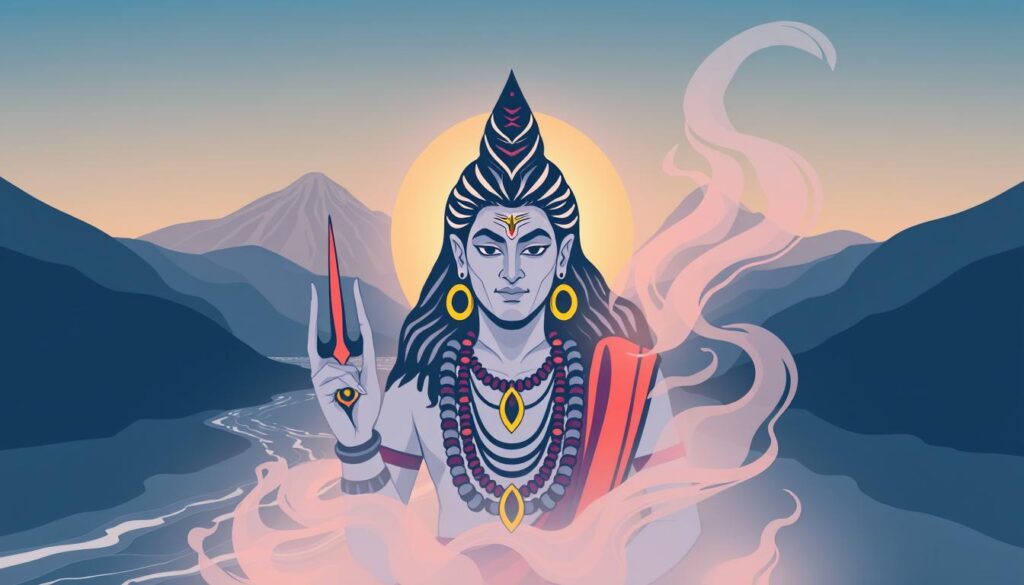
Lord Shiva, the mysterious god of Hinduism, is known for his deep and complex nature. His images are full of symbols, each with a deep spiritual meaning. These symbols are surrounded by fascinating stories, drawing people in and revealing the rich world of Hindu mythology.
Key Takeaways
- Lord Shiva’s complex iconography is replete with symbolic meanings derived from captivating mythological tales.
- These divine stories explore themes of creation, preservation, and destruction, as well as the balance between them.
- Shiva’s blue throat, third eye, snake-adorned neck, and the River Ganga in his hair all have fascinating origins in Hindu mythology.
- The mythological narratives surrounding Shiva’s images provide a deeper understanding of Hindu philosophy and the nature of existence.
- These tales not only entertain but also convey important lessons about spiritual knowledge, humility, and the interconnectedness of the divine realms.
Origin and Significance of Lord Shiva in Hindu Mythology
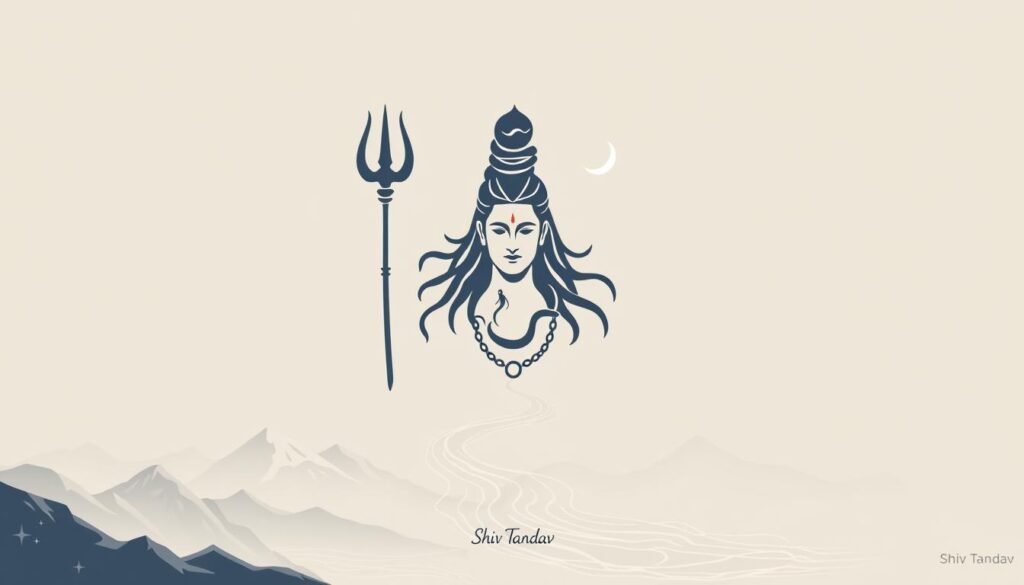
Lord Shiva, also known as Mahadeva or Rudra, is a key figure in Hindu mythology. He is one of the main deities of the Trimurti (the Hindu Trinity). Shiva is highly respected in Hindu traditions, especially in Shaivism. He is seen as the Supreme Lord who creates, protects, and transforms the universe.
The Trinity and Shiva’s Role
Shiva represents destruction and transformation in the Trimurti. Brahma creates, and Vishnu preserves. Shiva’s role is to dissolve and rebirth the universe. This cycle is key in Hindu cosmology, with Shiva keeping the cosmos balanced.
Symbolism of Shiva’s Physical Attributes
Shiva’s physical attributes hold deep symbolism. His blue throat, Neelkanth, shows his role as a savior who drank poison to save the world. The third eye on his forehead represents wisdom beyond the physical world. The snake around his neck symbolizes kundalini energy, the spiritual power at the base of the spine.
Different Names and Their Meanings
Shiva is known by many names, each showing a different side of his divine nature. Names like Mahadeva (the Great God), Nataraja (the Lord of Dance), and Rudra (the Fierce One) highlight his complexity. These names, along with others, show the many facets of this Hindu deity.
| Name | Meaning |
|---|---|
| Mahadeva | The Great God |
| Nataraja | The Lord of Dance |
| Rudra | The Fierce One |
| Bhairava | The Terrifying Aspect |
| Maheshvara | The Great Lord |
| Pashupati | The Lord of Beasts |
Shiva’s role in Hindu mythology is vast and complex. His symbolism and names reflect the many sides of his divine nature. As the Destroyer and Transformer, Shiva is crucial in the universe’s eternal cycle of creation, preservation, and dissolution.
The Story of Neelkanth: How Shiva Got His Blue Throat
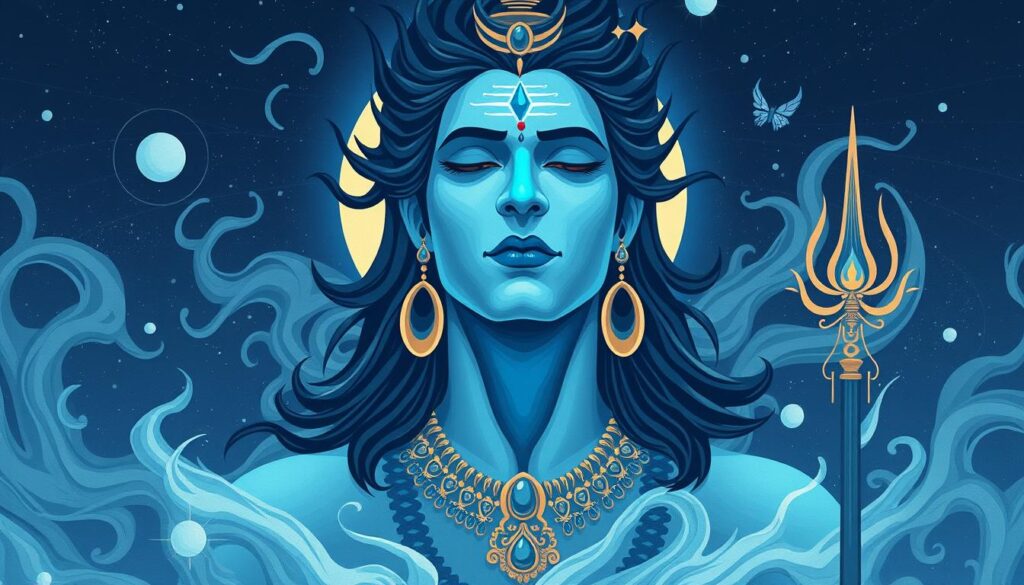
In Hindu mythology, the tale of Neelkanth, or the “Blue-Throated One,” is linked to the ancient churning of the cosmic ocean, known as the Samudra Manthan. The legend says that during this event, the deadly Halahala poison emerged, threatening to destroy all of creation. Lord Shiva, as the protector of the universe, selflessly swallowed the poison, preventing it from causing harm.
As Shiva swallowed the poison, his wife, the goddess Parvati, pressed her hands against his throat. This act prevented the toxin from spreading further. Shiva’s throat turned a deep, mesmerizing blue, earning him the revered title of Neelkanth. This shows Shiva’s willingness to bear the world’s poisons for the greater good and his ability to contain and expel negative energies.
The story of Neelkanth highlights Shiva’s divine qualities. It shows his mastery over dualities, his ability to transcend material limitations, and his acceptance of all aspects of existence. From a psychological view, Shiva’s blue throat represents the Self, the Shadow, and the Id. It symbolizes the journey of purification and integrating one’s darker aspects.
In the spiritual realm, the Vishuddha chakra, linked to communication, expression, and creativity, is often depicted as a blue lotus. This emphasizes the importance of Shiva’s blue throat. The tale of Neelkanth reminds us of the need for introspection, containing personal and societal prejudices, and transforming toxicity into strength and resilience.
“The story of Neelkanth reminds us that true power lies in the ability to embrace and transmute the darkness within, for it is only through this process that we can truly become the guardians of the cosmic balance.”
The Cosmic Dance: Tale of Shiva Nataraja and Apasmara
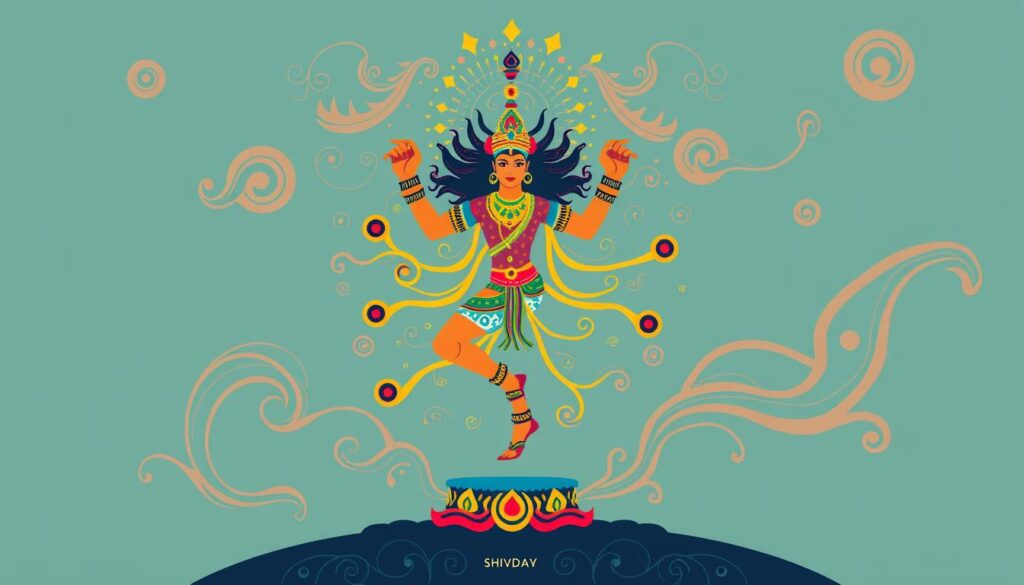
The Nataraja form of Shiva shows him dancing in a cosmic dance. This dance is about creation and destruction. Shiva dances on the demon Apasmara, who stands for ignorance and illusion.
This image is very meaningful. It shows Shiva’s Tandava dance. This dance represents the five main activities of the divine: creating, preserving, destroying, creating illusions, and freeing.
Significance of the Tandava Dance
The Tandava dance by Nataraja shows the universe’s endless cycle. Each part of the dance has deep meaning. For example, the snake around Shiva’s neck and the fire in his hand.
These parts show the balance of opposites in the universe. Like life and death, or order and chaos.
Symbolism Behind Each Movement
- The drum in Shiva’s upper right hand represents the sound of creation, the primal vibration that sets the universe in motion.
- The flame in his upper left hand symbolizes the fire of destruction, which consumes the old to make way for the new.
- His lower right hand is in the “fear not” gesture, reassuring devotees of his protective nature.
- The lower left foot crushing the demon Apasmara represents the triumph of knowledge over ignorance.
Shiva’s cosmic dance is a deep spiritual symbol. It has inspired many artists, dancers, and worshippers. The Tandava’s beauty reminds us of the universe’s cycles of change.
“The Nataraja image is a magnificent visual summary of key Hindu philosophical principles – the dynamic equilibrium of opposites, the cycles of creation and destruction, and the transformation of the universe.”
Birth of Ashok Sundari: The Lesser-Known Tale
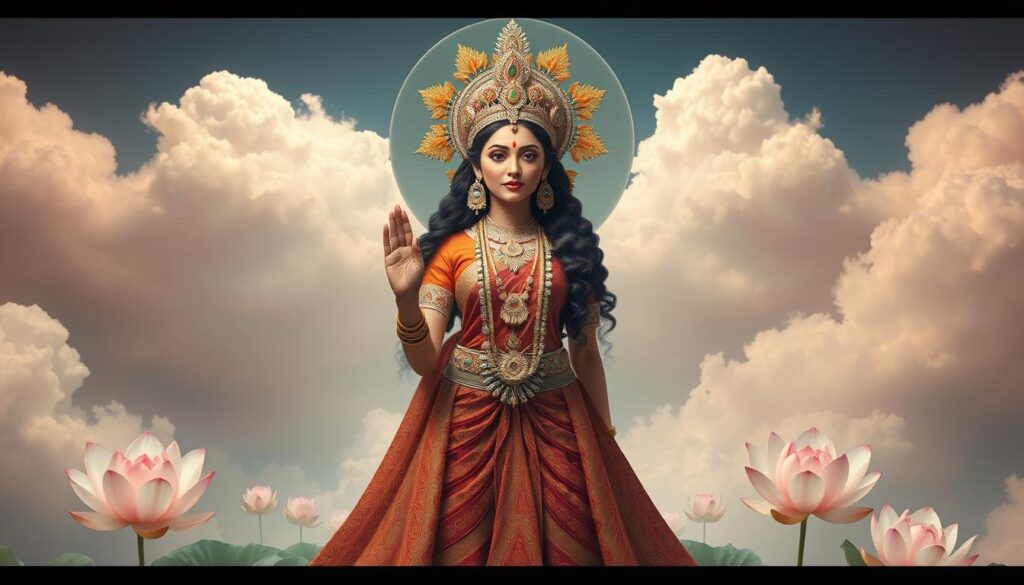
The stories of Lord Ganesha and Lord Kartikeya are well-known in Hindu mythology. But the tale of Ashok Sundari, their lesser-known sister, is not as famous. The Padma Purana tells us that Ashok Sundari was born to Lord Shiva and Goddess Parvati. She was born when Parvati wished for a child from the divine Kalpavriksha tree.
Ashok Sundari’s name means “without sorrow” and “beautiful.” It shows her divine lineage and the blessings from her parents. Her story is linked to the tragic event of Lord Ganesha’s beheading. She was cursed by Parvati for not showing courage to stop it.
Even though Ashok Sundari is not often mentioned in Hindu scriptures, her story fascinates many. Her connection to the Kalpavriksha tree and her marriage to Nahush, the son of King Ayus and Queen Prabha, make her story complex.
Ashok Sundari’s tale reminds us of the rich world of Hindu mythology. Even the lesser-known figures have their own importance and add to our understanding of the divine.
“Ashok Sundari, the daughter of Lord Shiva and Goddess Parvati, is a relatively mysterious figure in Hindu mythology, yet her story holds profound symbolic meaning.”
Mythological Stories Associated with Shiva’s Images
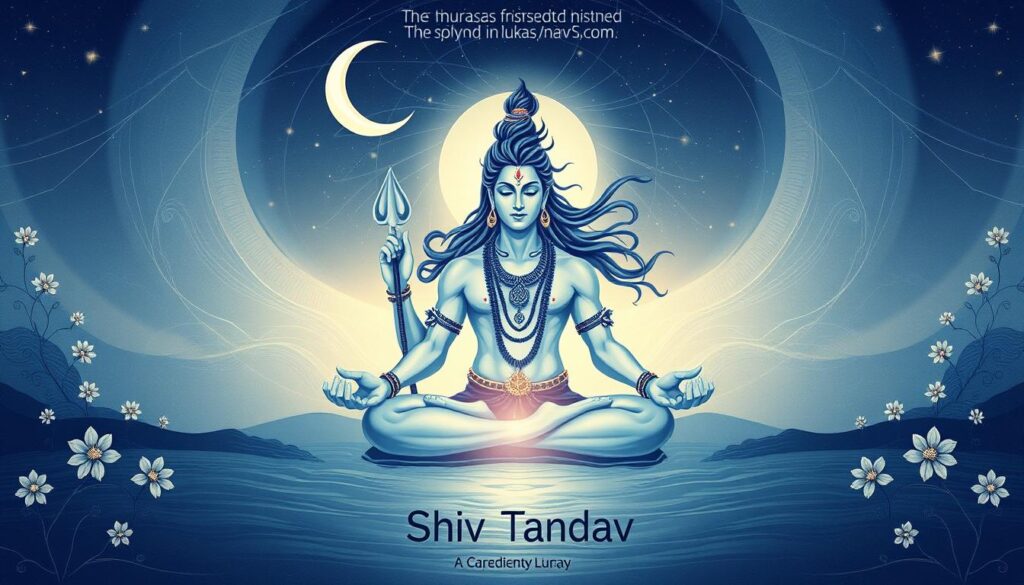
Lord Shiva’s images are filled with sacred symbols. Each symbol holds deep mythological meaning. The Shiva lingam shows the divine’s formless nature, symbolizing life’s source. The trishul, or trident, represents the three gunas or qualities of nature – Sattva, Rajas, and Tamas.
The damru, Shiva’s hand drum, is said to have created the first sound, starting the universe. The rudraksha beads, from Shiva’s tears of compassion, are worn by him. These symbols have been in Shiva’s art for ages, changing styles but keeping their meanings.
Sacred Symbols and Their Origins
- The Shiva lingam represents the formless, infinite nature of the divine.
- The trishul (trident) symbolizes the three gunas or qualities of nature: Sattva, Rajas, and Tamas.
- The damru (drum) represents the primordial sound that birthed the universe.
- The rudraksha beads worn by Shiva are said to have originated from his tears of compassion.
Visual Representations Through Ages
These sacred symbols have been in Shiva’s images for ages. They have evolved in style but kept their deep meanings. From ancient stone carvings to bronze statues of the Chola dynasty, Shiva’s images have been celebrated in India’s rich culture.
“Lord Shiva’s images are a tapestry of mythological narratives, weaving together the threads of the divine and the human experience.”
The Legend of Mount Kailash and Ravana

Mount Kailash is a towering peak in the Himalayas. It is said to be the home of Lord Shiva in Hindu stories. This mountain has sparked many legendary tales, one being about the demon king Ravana.
Ravana, a huge fan of Shiva, tried to move Mount Kailash to Lanka. Shiva got mad and pressed his toe on the mountain, trapping Ravana. Ravana then used his tendons as strings to play music, singing Shiva’s praises for years.
Shiva forgave Ravana after his endless devotion. He freed Ravana from the mountain’s weight. This shows Shiva’s power and his ability to forgive even the toughest foes.
“Whoever drinks the water of Lake Mansarovar will directly go to the abode of Lord Shiva after death and be cleansed of all sins.”
The story of Mount Kailash and Ravana is closely linked to Shiva’s story. It talks about divine punishment and forgiveness. Every year, thousands of pilgrims come to seek spiritual enlightenment and Shiva’s blessings.
| Fact | Statistic |
|---|---|
| Average height of Kailash Parvat | 21778 ft |
| Time taken to complete Kailash parikrama (Circumambulation) | 2.5-3 days |
| Number of rivers emerging from Kailash | 4 (Sutlej, Brahmaputra, Karnali, Indus) |
| Number of sacred sites mentioned at the Kailash Manasarovar Lake | 51 |
How the Ganga Came to Rest in Shiva’s Hair
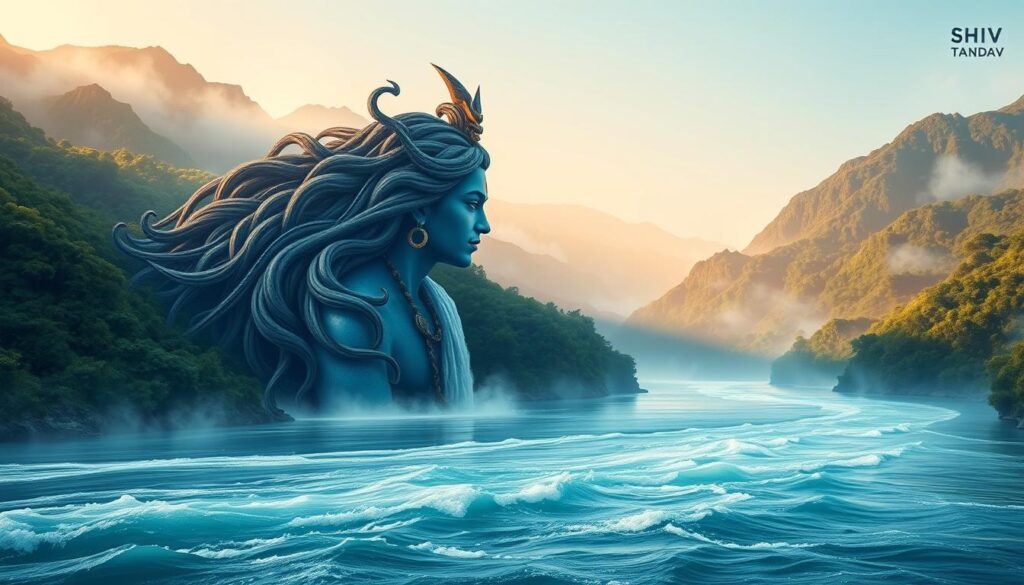
The story of the Ganga River’s journey from the sky to Earth is a key part of Hindu myths. It starts with King Bhagiratha, a member of the Ikshvaku dynasty. He wanted to bring the Ganga to Earth to clean the souls of his ancestors.
The Story of King Bhagiratha
Legends say the Ganga’s arrival was meant to be a grand event. King Sagara, Bhagiratha’s ancestor, had done a big ritual. But, the sage Kapila stopped it, causing the death of Sagara’s sixty-thousand sons.
Bhagiratha, the seventh in line, worked hard to convince the gods. He wanted the Ganga to come down and wash away the sins of his ancestors.
Seven Sacred Streams
- When the Ganga came down, her power was so great it could have destroyed the Earth. Shiva, the Hindu god, caught her in his hair, saving the planet.
- Shiva then let the Ganga flow in seven sacred rivers: Bhagirathi, Janhvi, Bhilangana, Mandakini, Rishiganga, Saraswati, and Alaknanda.
- These seven rivers are seen as very special in Hinduism. They are believed to have come from the sky and have the power to purify.
The myth of the Ganga’s journey and Shiva’s role shows the deep respect for the river in Hinduism. It tells us about the river’s power to cleanse the soul. This story has touched many hearts around the world, showing the Ganga’s importance in Indian culture and spirituality.
“The eternal flow of the Ganga symbolizes the eternal nature of the soul in Hindu beliefs.”
The Tale of Shiva’s Third Eye
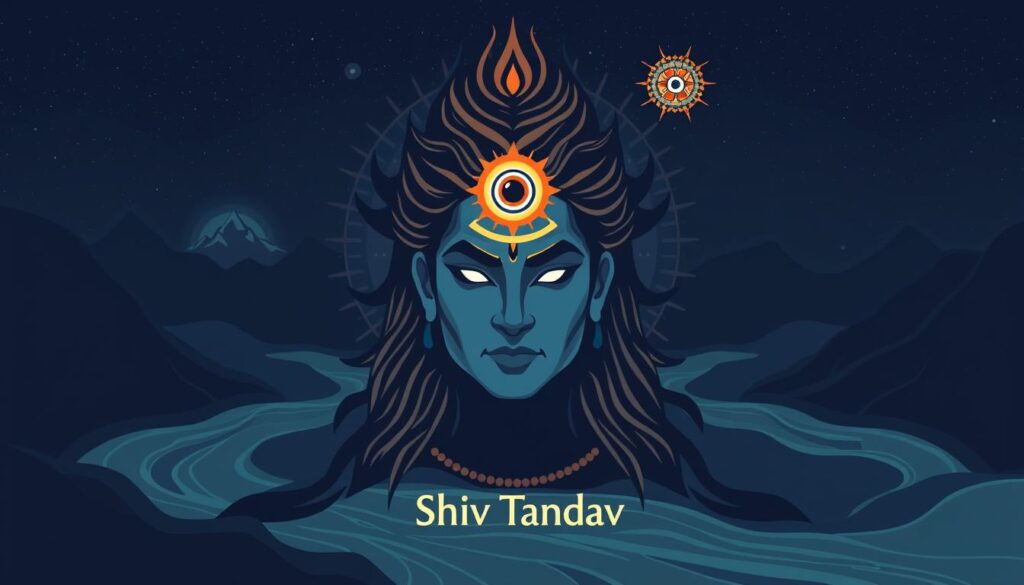
Lord Shiva, the top god in Hindu myths, has a third eye on his forehead. This eye is linked to wisdom, insight, and the power to fight evil. The story of Shiva’s third eye is filled with divine power and the search for spiritual growth.
The famous story of Shiva’s third eye is about Kama, the god of love. Parvati, Shiva’s wife, once covered his eyes, causing darkness. Shiva then opened his third eye, sending fire that killed Kama. This shows Shiva’s power to go beyond physical desires and reach a higher consciousness.
The third eye is called the “Trilochan” or “wisdom eye.” It lets Shiva see beyond the physical world. He gains a deeper understanding of the universe and its cycles.
“Shiva’s third eye represents the sun and the moon: left eye signifies the moon, and the right eye symbolizes the sun.”
Shiva’s third eye opening shows his divine power and spiritual awakening. It means seeing the world with more wisdom and insight by going beyond physical senses.
The tale of Shiva’s third eye has inspired many for centuries. It reminds us of the value of spiritual growth, overcoming desires, and the potential in each person.
Story of the Snake Around Shiva’s Neck
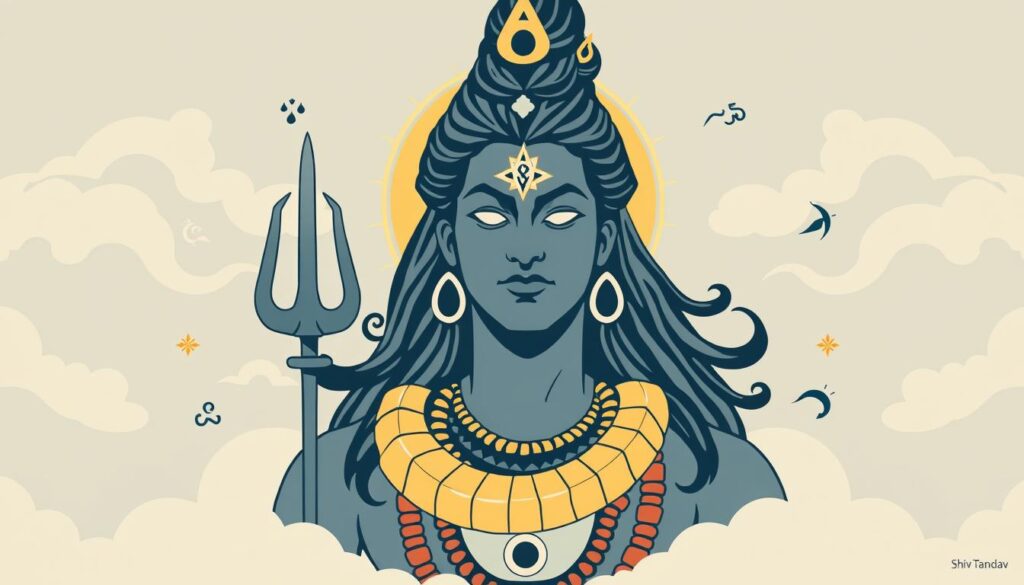
In Hindu mythology, the snake around Shiva’s neck is very important. It shows Shiva’s control over death and his role in creation and destruction.
Vasuki and the Samudra Manthan
The snake is often Vasuki, the king of serpents. During the Samudra Manthan, Vasuki was used as a rope. Shiva was impressed by Vasuki’s bravery and accepted it around his neck.
Symbolic Meaning of the Serpent
The snake around Shiva’s neck means many things in Hinduism. It stands for kundalini energy, the spiritual power at the base of the spine. It also shows Shiva’s control over time, death, and desires.
By wearing the snake, Shiva shows he can change bad things into good. In Hindu tradition, snakes protect the earth and sacred places. The snake on Shiva’s body shows balance between creation and destruction.
“The snake around Shiva’s neck represents a complex interplay of themes such as power, protection, transformation, and transcendence in Hindu tradition.”
Stories of the snake around Shiva’s neck vary in Hindu texts and traditions. But they all show Shiva’s power to control and use the world’s destructive forces for good.
The Sacred Union: Tales of Shiva and Parvati
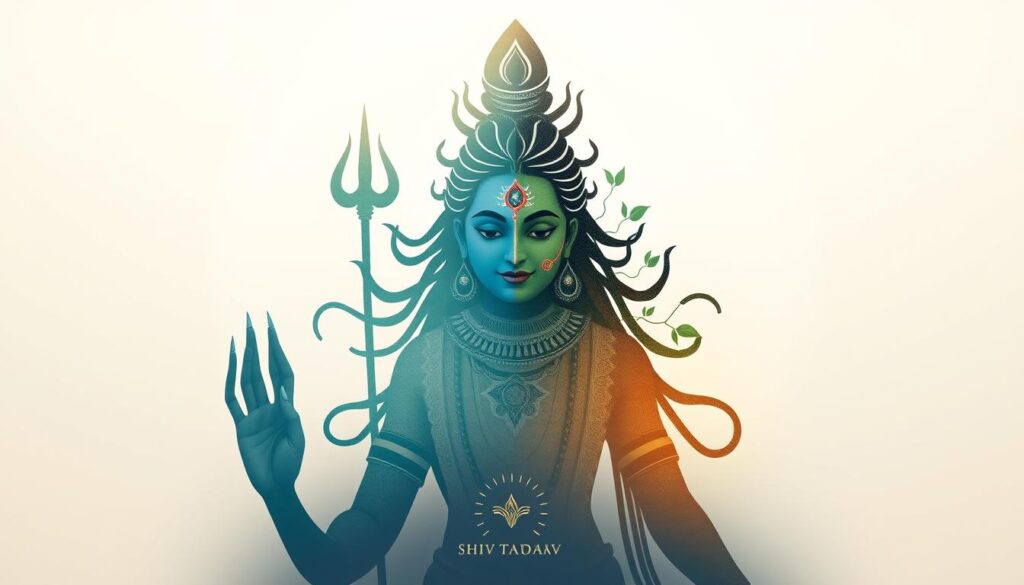
In Hindu mythology, the love story of Lord Shiva and Goddess Parvati is a timeless tale. It shows the balance between male and female energies. This balance is what makes the universe work.
Parvati’s journey to win Shiva’s heart was filled with hard work and love. She called him “Shiva” when she was born, showing she was meant to be with him. Her mother, Queen Menadevi, went through great spiritual challenges to help their union.
Shiva tested Parvati’s love by hiding his true identity. But Parvati’s love never wavered. Their wedding, with the help of the Himalayan king and queen, was a grand event.
Their marriage, blessed by the Vedas and Lord Brahma and Goddess Saraswati, shows the connection between consciousness and energy. The Ardhanarishvara form, showing Shiva and Parvati as one, shows their inseparable bond.
The union of Shiva and Parvati is a symbol of love’s power. It shows how male and female energies can come together in harmony.
“The marriage of Lord Shiva and Goddess Parvati is a tale that resonates with devotion, perseverance, and the enduring power of love in Hindu mythology.”
The stories of Shiva and Parvati give deep insights into Hindu philosophy. They talk about consciousness, energy, and the divine. Their love story inspires many, reminding us of the sacred bond at the universe’s heart.
Legend of the Ash-Covered Body
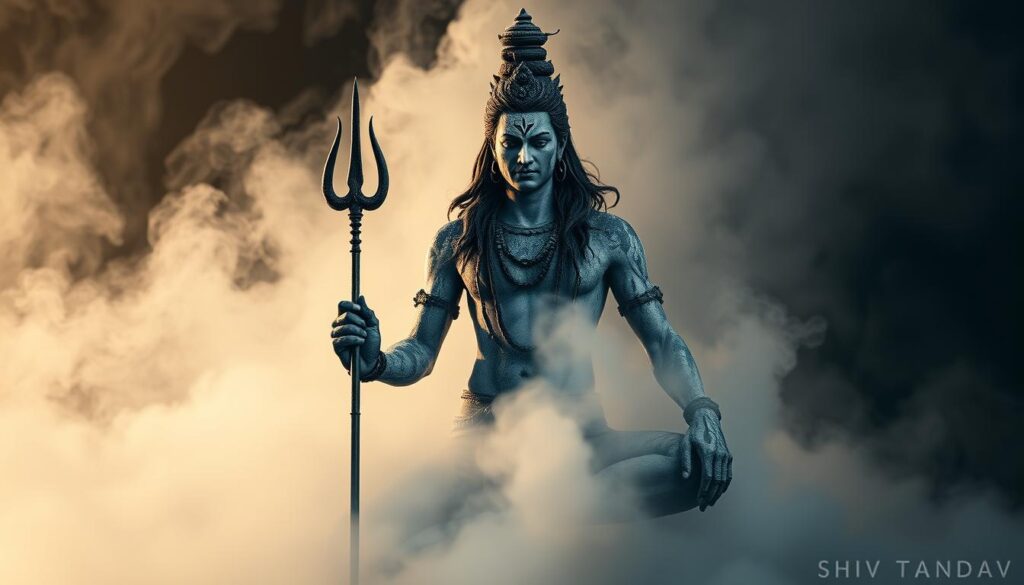
In Hindu mythology, Lord Shiva’s ash-covered body is very meaningful. A story tells of a sage named Parnada who was very proud of his spiritual work. Shiva got angry and wanted to teach him a lesson about the short life of the body.
Shiva cut himself, but instead of blood, ash came out. This showed Shiva’s complete separation from the world. The ash, or vibhuti, shows the truth that remains after everything is gone, teaching us about life’s shortness and the soul’s eternity.
The story of Shiva’s body covered in ash is a strong symbol in Hindu traditions. The sacred ash means Shiva can purify and change things, giving grace and showing the real truth. It reminds us to be humble, not attached, and to seek spiritual growth.
The symbolism of ash in Shiva’s image goes back to ancient times and is seen in many cultures. For Shiva’s followers, seeing his ash-covered form shows his power over life, death, and the cycle of existence.
“The ash-covered body of Shiva embodies the essence of detachment, mortality, and the cyclical nature of the universe. It is a testament to the profound wisdom and transcendence of the divine.”
The legend of Shiva’s ash-covered body teaches Hindus about the short life of material things and the need for spiritual awareness. This image inspires devotion and thought in those who follow the Shaivite tradition.
The Divine Test: Lord Vishnu and the Sudarshan Chakra
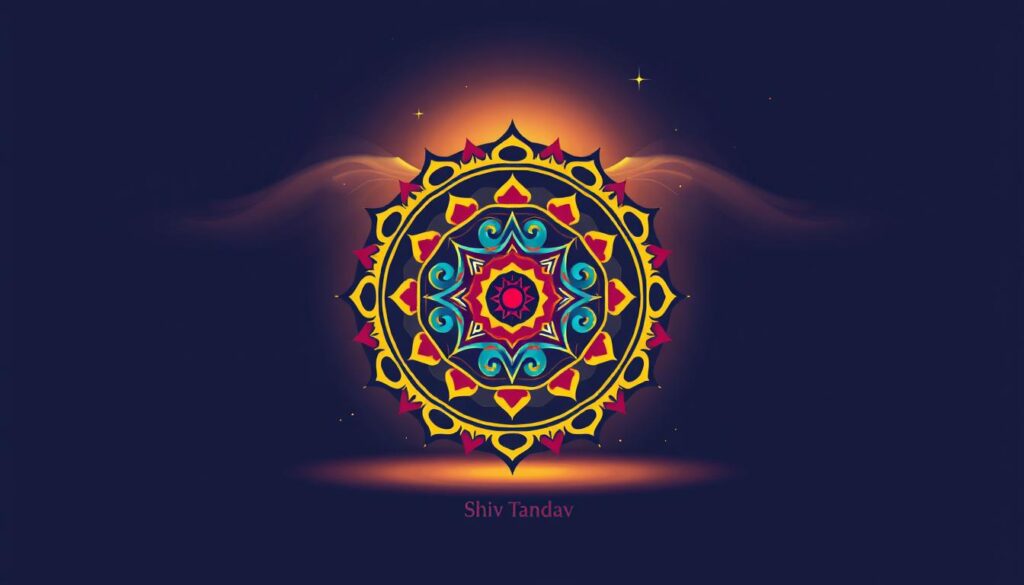
In Hindu mythology, the story of Lord Vishnu and the Sudarshan Chakra shows the bond between Shiva and Vishnu. This bond is part of the divine Hindu Trinity. The tale tells how Vishnu’s devotion to Shiva was tested, leading to a significant change in the cosmos.
Vishnu was offering flowers to Shiva while reciting a thousand divine names. Shiva removed one flower to test Vishnu’s devotion. Vishnu, feeling distressed, took out his own eye and gave it as the missing flower. This act showed his deep commitment to Shiva’s worship.
Shiva was moved by Vishnu’s act of devotion. He gave Vishnu the Sudarshan Chakra, a divine discus with the light of ten thousand suns. This weapon, filled with Shiva’s grace, helped Vishnu fight evil and bring balance to the universe.
The story of the Sudarshan Chakra highlights the respect and reverence between Shiva and Vishnu. It shows the power of true devotion and the divine rewards it brings.
“The tale of Vishnu and the Sudarshan Chakra illustrates the deep connection between Shiva and Vishnu, and the power of true devotion.”
Today, this mythological story continues to inspire many. It encourages them to start their own spiritual journeys, guided by devotion and divine grace.
| Key Moments in the Tale | Significance |
|---|---|
| Vishnu recites a hymn of a thousand divine names of Shiva | Demonstrates Vishnu’s deep reverence and devotion towards Shiva |
| Shiva removes one flower from Vishnu’s offering | Tests Vishnu’s unwavering commitment to Shiva’s worship |
| Vishnu plucks out his own eye as the missing flower | Showcases the ultimate act of devotion and sacrifice |
| Shiva grants Vishnu the Sudarshan Chakra | Rewards Vishnu’s devotion with a powerful divine weapon |
Tales of the Unakoti Rock Carvings
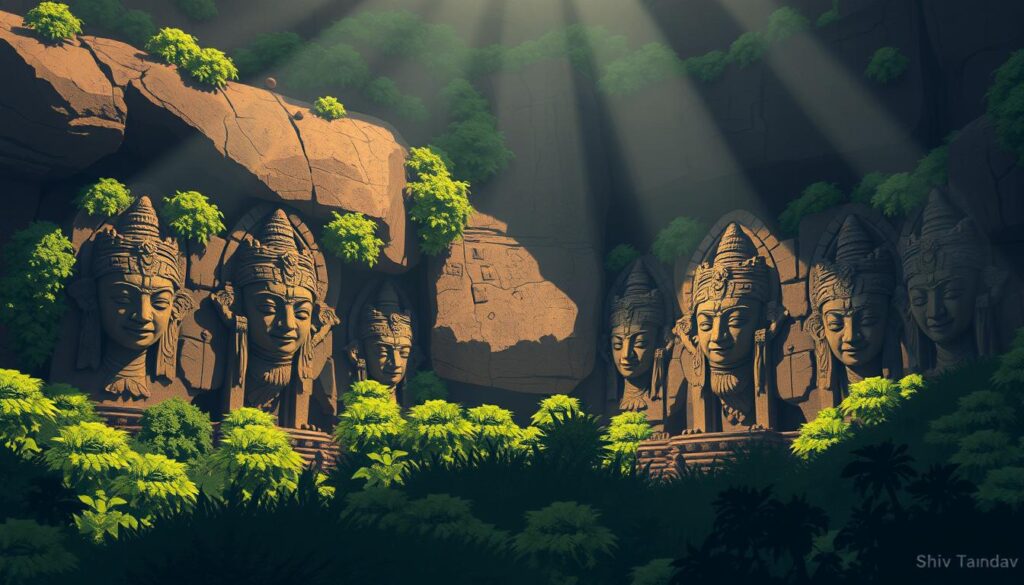
In the northeastern state of Tripura, India, lies the Unakoti rock carvings. They tell a story of divine transformation. It’s said that Lord Shiva and his 99,99,999 gods and goddesses rested here on their way to Kashi.
The Story of Stone Transformation
Legend says Shiva told his companions to wake before sunrise. But only he woke up. Shiva turned the sleeping deities into stone sculptures. This left behind a stunning display of Hindu iconography. The name ‘Unakoti’ means ‘less than one crore’, telling this mythical tale.
Historical Significance
The Unakoti rock carvings date back to the 7th-9th centuries CE. They are a remarkable example of ancient craftsmanship. A 30-feet tall Shiva’s head, known as Unakotiswara Kal Bhairava, is at the center. It’s surrounded by goddesses, Hanumana, Ganesha, Ravana, and other deities from Hindu mythology.
These intricate rock-cut figures show a mix of tribal and Hindu influences. Unakoti is a significant cultural and historical site. Over the years, Unakoti has become a major Hindu pilgrimage destination. Thousands of devotees visit during the annual Ashokastami Mela festival in April.
But, the site has faced neglect, causing the rock art to degrade. Now, efforts are underway to preserve and develop Unakoti. In 2022, it was added to the tentative list of UNESCO World Heritage Sites.
“The Unakoti rock carvings are a testament to the rich cultural heritage of Tripura, capturing the imagination of visitors with their mythological tales and exquisite craftsmanship.”
The Story Behind Shiva’s Damru
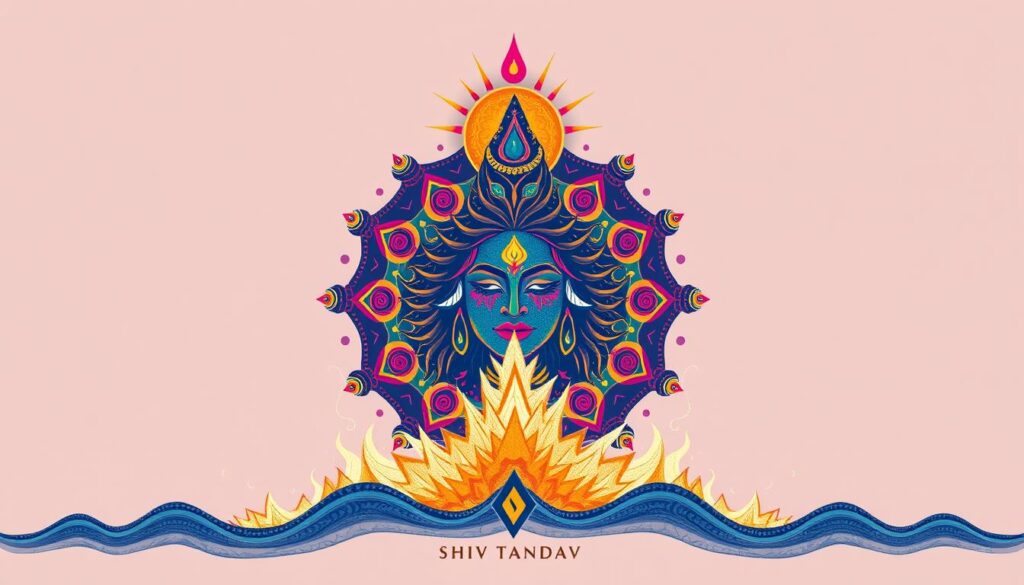
The damru, a small hourglass-shaped drum, is more than a musical tool. It’s a symbol of creation and destruction in Hindu mythology. It’s said that the first sounds of creation came from Shiva’s damru, starting the sacred Sanskrit language.
The damru’s shape shows the union of male and female, reflecting the universe’s balance. Its sounds carry all cosmic frequencies, showing life’s cycle. During Shiva’s dance, the damru’s beats echo through time, marking existence’s rhythm.
In tantric traditions, the damru is linked to Om, the sound of creation. Its sound is believed to bring forth the sacred vibration of Om. This shows the damru’s role in connecting us to the universe’s divine forces.
Legends say the damru’s sounds inspired the Maheshwara Sutras, a key text on Sanskrit. Panini, a great scholar, was inspired by Shiva’s damru rhythms to write his work on Sanskrit grammar.
Today, the damru is still valued for meditation and connecting with the divine. Its sound and meaning are key in Hindu rituals and art, linking us to ancient wisdom.
“The Damru, a drum associated with Lord Shiva in Hindu mythology, has been dated back to the 10th century C.E.”
Conclusion
The stories of Lord Shiva are filled with spiritual wisdom and cultural heritage. They tell of the cosmic dance of Nataraja and the union with Parvati. Each tale offers deep insights into existence and the balance of opposites.
These stories inspire millions of Hindu followers. They teach us about life, death, and the cycle of creation and destruction. They guide us on our spiritual journey.
The symbols and images of Shiva, like Ardhanarishvara, have shaped Hindu art and literature. These stories keep the Vedic tradition alive. They show the lasting impact of Hindu legends on culture and devotion.
Exploring Shiva’s mythology helps us understand the universe’s fundamental principles. Shiva’s stories teach us about the balance between creation and destruction. They invite us to find harmony in life’s dualities and seek spiritual enlightenment.
FAQ
Who is Lord Shiva and what is his role in Hindu mythology?
Lord Shiva is a key figure in Hindu mythology. He is seen as a creator, preserver, and destroyer. He is part of the Trimurti, along with Brahma and Vishnu, representing destruction and change.
What are the symbolic meanings behind Shiva’s physical attributes?
Shiva’s appearance is full of symbols. His blue throat, third eye, snake, and the river Ganga in his hair all have deep meanings. Each part of his look tells a story of spiritual and philosophical ideas.
What are some of the different names by which Shiva is known and what do they represent?
Shiva is known as Mahadeva, Nataraja, and Neelkanth. Each name shows a different side of his divine nature.
What is the story behind Shiva’s blue throat?
Shiva’s blue throat comes from a myth about the cosmic ocean. When poison Halahala came out, Shiva drank it to save the world. His wife, Parvati, pressed his throat to stop the poison from harming him, leaving his throat blue.
What is the significance of Shiva’s Nataraja form and the Tandava dance?
Shiva’s Nataraja form shows him dancing, creating and destroying the universe. The Tandava dance represents God’s five actions: creating, preserving, destroying, creating illusions, and freeing. Each part of the dance has deep meanings, showing cosmic cycles and the balance of opposites.
What is the story of Ashok Sundari, Shiva’s daughter?
Parvati wished for a daughter from the Kalpavriksha tree. Her wish was granted, and Ashok Sundari was born. Her name means “without sorrow” and “beautiful.” This story shows Shiva and Parvati’s family side, often overshadowed by their sons.
What are the sacred symbols associated with Shiva and their origins?
Shiva’s images have sacred symbols like the Shiva lingam and the trishul. The Shiva lingam shows the divine’s formless nature. The trishul represents the three qualities of nature. The damru is the sound of creation. Rudraksha beads, from Shiva’s tears, are also sacred.
What is the legend behind Mount Kailash and Ravana?
Mount Kailash is Shiva’s home, featured in many myths. One story is about Ravana trying to lift it. Shiva pressed his toe on the mountain, trapping Ravana. Ravana then made music with his tendons to please Shiva.
How did the Ganga come to rest in Shiva’s hair?
King Bhagiratha wanted to bring the Ganga to Earth. When Ganga fell, Shiva caught her in his hair. He then released her in seven streams.
What is the significance of Shiva’s third eye?
Shiva’s third eye is for wisdom and insight. A story says Parvati covered his eyes, causing darkness. Shiva opened his third eye, bringing light and fire. This eye sees beyond the surface, understanding reality.
What is the symbolism behind the snake around Shiva’s neck?
The snake around Shiva’s neck is Vasuki, the ocean’s serpent. It symbolizes kundalini energy and Shiva’s power over death. It shows his ability to change poison into nectar.
What does the union of Shiva and Parvati represent?
Shiva and Parvati’s union shows the balance of male and female energies. Their love story includes Parvati’s penance and their divine marriage. The Ardhanarishvara form shows their inseparable nature.
What is the significance of Shiva’s body covered in ash (vibhuti)?
Shiva’s ash-covered body has deep meaning. A tale says Shiva showed true detachment by cutting himself, producing ash. The ash represents the ultimate reality after all else is gone.
What is the story behind the Sudarshan Chakra and its connection to Shiva and Vishnu?
Vishnu and the Sudarshan Chakra show Shiva and Vishnu’s connection. Vishnu offered flowers to Shiva, who removed one. Vishnu gave his eye as the flower, impressing Shiva. Shiva then gave Vishnu the Sudarshan Chakra.
What is the legend behind the Unakoti rock carvings and their association with Shiva?
The Unakoti rock carvings in Tripura are linked to a Shiva legend. Shiva was traveling with a crore gods and goddesses. They stopped for the night, but Shiva was the only one awake. He turned the others into stone before leaving.
What is the significance of Shiva’s damru (drum)?
Shiva’s damru is more than a drum. It’s a symbol of cosmic creation. The first sounds of creation came from it. These sounds are the origin of Sanskrit. The damru’s shape and sound represent the universe’s vibrations.
